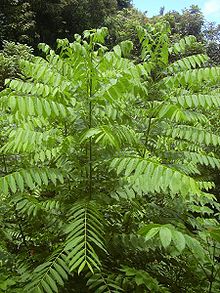Cedrela odorata
This article needs additional citations for verification. (December 2012) |
| Cedrela odorata | |
|---|---|

| |
| Scientific classification | |
| Kingdom: | Plantae |
| Clade: | Tracheophytes |
| Clade: | Angiosperms |
| Clade: | Eudicots |
| Clade: | Rosids |
| Order: | Sapindales |
| Family: | Meliaceae |
| Genus: | Cedrela |
| Species: | C. odorata
|
| Binomial name | |
| Cedrela odorata | |
| Synonyms[2] | |
|
List
| |
Cedrela odorata, commonly known as Spanish cedar, Cuban cedar, or cedro in
Classification
This section needs additional citations for verification. (March 2017) |
The genus Cedrela has undergone two major systematic revisions since 1960. The most recent revision reduced the number of species in the genus to seven (Styles, 1981). Cedrela odorata L., contains 28 other synonyms, including C. mexicana M. J. Roem. The taxon "C. angustifolia," a very vigorous type now in demand because of its apparent resistance to the shootborer, was left in an indeterminate status due to insufficient herbarium material. The result is that C. odorata as now constituted is a species showing a high degree of population variation.
Distribution and habitat

Cedro is a tree of the
Description
The tree is
Uses
Cedrela odorata is the most commercially important and widely distributed species in the genus Cedrela. Known as Spanish cedar in English commerce, the aromatic wood is in high demand in the American tropics because it is naturally
See also
- Cedar wood
- List of honey plants
References
- . Retrieved 19 November 2021.
- ^ "The Plant List: Cedrela odorata L." Royal Botanic Gardens, Kew and Missouri Botanic Garden.
- ^ Selected plants of Galapagos Islands
- ^ "Forest of daisy trees in Santa Cruz | Wondermondo". 11 March 2012.
- ^ Yirka, Bob; Phys.org. "Galápagos giant tortoises study suggests they may be in danger due to invasive Cedrela odorata trees". phys.org. Retrieved 2024-03-25.
- ^ Romanillos, J.L. (2014) Making A Spanish Guitar
External links
 Data related to Cedrela odorata at Wikispecies
Data related to Cedrela odorata at Wikispecies- Cedro Hembra, Spanish-Cedar
- Overview of Cedrela odorata Archived 2014-11-12 at the Wayback Machine

